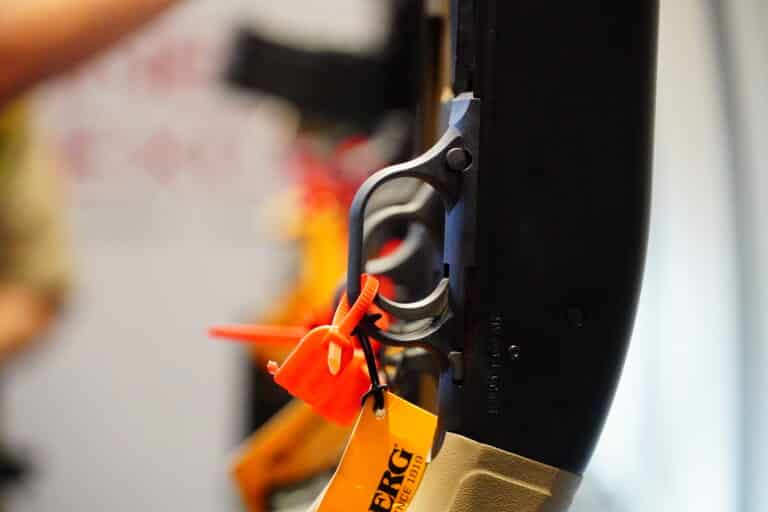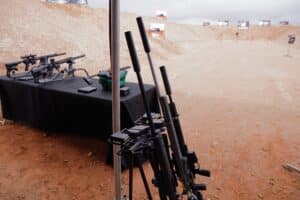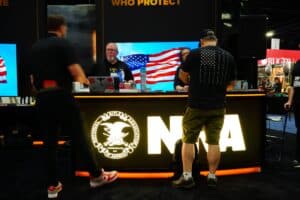The national gun-control groups have consistently outraised gun-rights groups like the NRA and its allies this cycle, but groups on both sides have ramped up their election spending substantially in recent weeks.
With just days to go until polls close, here’s a look at which races and candidates the major gun groups have invested most of their money.
National Rifle Association
Unlike in past elections, the NRA has relied entirely on its PAC to raise and spend money in the 2024 election. The group’s SuperPAC, the NRA Victory Fund, has not been employed for any outside spending despite the group using it to invest $19,452,528 in the last presidential race. The NRA Political Victory Fund (PVF), meanwhile, has reported $10,156,191 in outside spending as of Thursday, according to Federal Election Commission data compiled by OpenSecrets.
The bulk of that spending has been targeted at influencing the battle at the top of the ticket, with $2,230,496 going to support Former President Donald Trump and another $1,848,969 directed toward opposing Vice President Kamala Harris. Beyond the presidential contest, the PVF has spent the most in three Senate races key for Republicans’ hopes of retaking the US Senate. The group has spent $2,085,499 supporting Tim Sheehy (R.) and opposing incumbent Montana Senator Jon Tester (D.), $1,566,174 supporting Bernie Moreno (R.) and opposing incumbent Ohio Senator Sherrod Brown (D.), and $1,258,412 to help boost Pennsylvania Senate candidate Dave McCormick (R.) over incumbent Senator Bob Casey (D.).
Elsewhere on the Senate map, the NRA has spent five figures to boost Michigan’s Mike Rogers (R.), Arizona’s Kari Lake (R.), and incumbent Texas Senator Ted Cruz (R.).
In terms of House races, the group has been particularly involved in the battle for Maine’s Second Congressional District, where gun politics has loomed especially large this cycle over vulnerable incumbent Democrat Jared Golden’s re-election chances after he changed positions and endorsed an “assault weapons” ban following a mass shooting in his district. The group has spent $50,000 opposing Golden and another $57,019 in support of his challenger, Austin Theriault (R.). No other House race has received a six-figure investment from the group thus far.
The group has also reported $826,476 in direct contributions to Republican PACs, party organizations, and individual candidates nationwide.
Everytown for Gun Safety
The country’s largest gun-control group, Everytown, has allocated $9,404,337 in outside spending to date this cycle, entirely through its Everytown for Gun Safety Victory Fund Super PAC.
Like the NRA, the bulk of the group’s outside spending has been directed at the presidential race. Everytown has spent $3,086,110 on campaign content supporting Harris and opposing Trump, according to OpenSecrets.
Unlike the NRA, however, the group’s biggest down-ballot expenditure has been in a single House contest. Everytown has spent $1,030,803 targeting incumbent Republican congressman Marc Molinaro in New York’s 19th Congressional district in what is considered one of the tightest races in the country. Overall, the group appears to be prioritizing tightly contested House races—primarily in states like New York and California— this cycle. $4,296,685 of the group’s outside spending total has gone to congressional races. The group has also poured big money into Senate races in Michigan and Pennsylvania. Everytown reported spending just over $1 million each opposing Republican challengers McCormick and Rogers.
The group has also reported $5,539,619 in contributions to individual candidates, Democratic party organizations, and progressive PACs.
Giffords
Giffords PAC, another leading gun-control group, has reported $7,175,600 in outside spending. The group spent the most money, $1,604,341, opposing Trump’s bid to retake the White House. Elsewhere, it appears to have been undertaking a similar strategy to Everytown by investing primarily in swing district House races.
The group’s biggest down-ballot investments have all been in competitive congressional seats currently held by Republicans. Giffords PAC has spent $1,168,151 attempting to unseat Mike Garcia in California’s 27th district, $1,066,503 to unseat Juan Ciscomani in Arizona’s sixth district, and $929,846 opposing Don Bacon in Nebraska’s second district. In total, $4,326,509 of the group’s outside expenditures have gone toward House races.
The group’s only Senate race involvement is in Pennsylvania, where it has spent $497,750 opposing McCormick’s bid to unseat Casey. Additionally, the group has reported $151,408 in contributions to individual candidates, Democratic party organizations, and progressive PACs.
Smaller Players
On the gun-control side, Brady has reported $34,165 in contributions to candidates, campaigns, and other outside groups, plus $122,500 in independent expenditures solely focused on the Presidential race.
Meanwhile, on the gun-rights side, alternatives to the NRA have spent just a fraction of the money it has pumped into the election. The National Shooting Sports Foundation (NSSF) reported $840,519 in contributions going primarily toward Republican candidates (with the exception of Democrat Mary Peltola in Alaska), conservative PACs, and Republican party organizations. Additionally, the NSSF’s Protect Liberty Super PAC has reported $306,663 in outside spending to boost the Republican candidate in each of the US Senate races in Pennsylvania, Montana, Ohio, Nevada, Wisconsin, and Michigan.
Gun Owners of America has reported $37,737 in contributions to various Republican candidates, party organizations, and conservative PACs. The group’s Super PAC has also reported $1,280,013 in outside spending focused on federal legislative races. Its most significant investment has been $619,969 to support Senator Cruz, followed by $293,867 to support Sheehy’s bid to flip Montana’s Senate seat.
The National Association for Gun Rights has reported $56,505 in contributions to various Republican causes, including several failed primary challengers. The group’s Gun Rights America Super PAC has also reported $192,805 in outside spending, with its biggest campaign going against Utah Republican John Curtis’ bid for the US Senate.
The US Concealed Carry Association for Saving Lives Super PAC has not reported any outside spending this cycle.
The Big Picture
Overall, the spending breakdown among the major gun groups comports with expectations based on each group’s fundraising trajectory throughout the year. The NRA, while still a significant spender and by far the most considerable presence on the gun-rights side, is simply no longer capable of matching the combined resources of the biggest gun-control groups when it comes to election spending, at least for the time being with its ongoing membership and fundraising woes.
Furthermore, an underlying strategy appears to be at play with where the groups are allocating their dollars. Both sides are spending big in the presidential election, where the two candidates present a stark contrast on gun policy, even if that policy debate has mostly taken a backseat to other issues this election. There is a clearer difference in strategy down ballot, though.
The gun-rights groups seem more confident about Republicans’ ability to regain control of the Senate, hence their focus on concentrating most of their down-ballot spending on just a handful of competitive Senate races. The gun-control groups, meanwhile, seem to think that their dollars are better spent attacking Republicans in highly competitive House races, where just a small handful of flipped seats can make all the difference in Democrats’ hopes of retaking the chamber after November.
By next week, the country will decide whether or not those strategies will have borne fruit.






